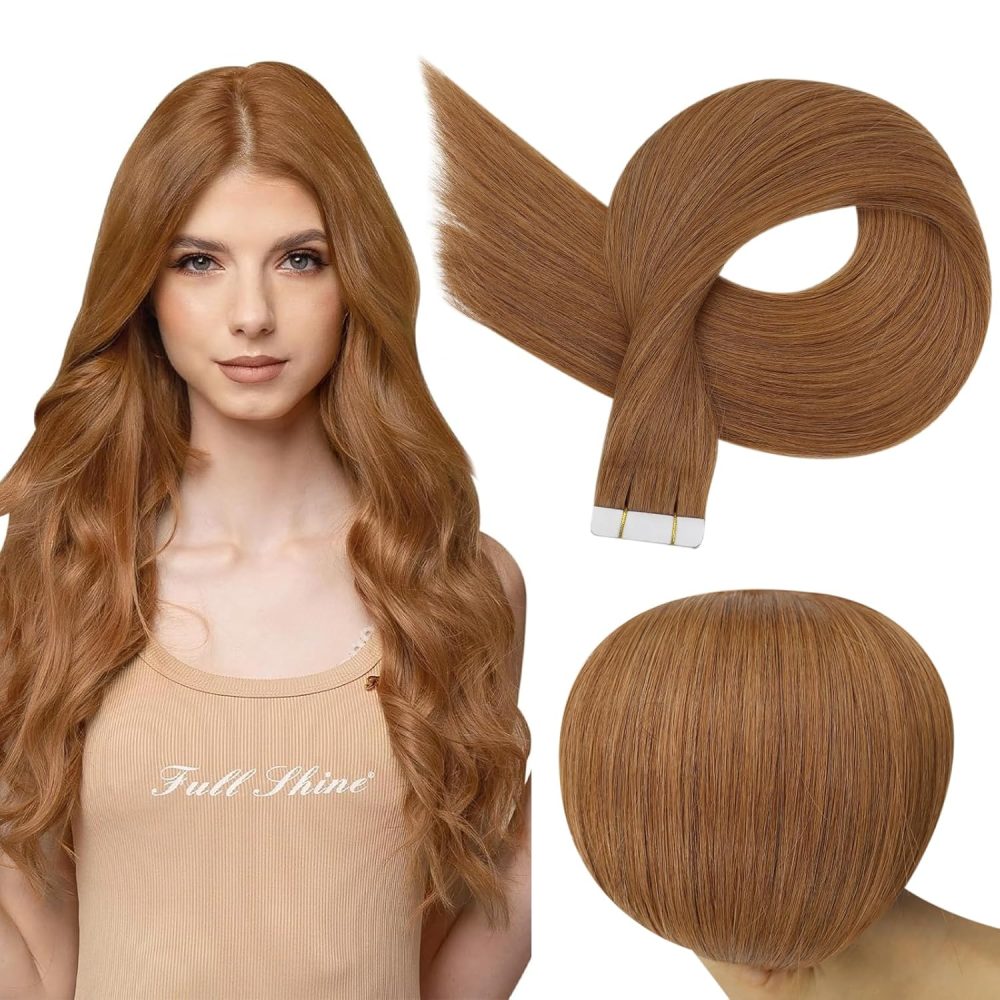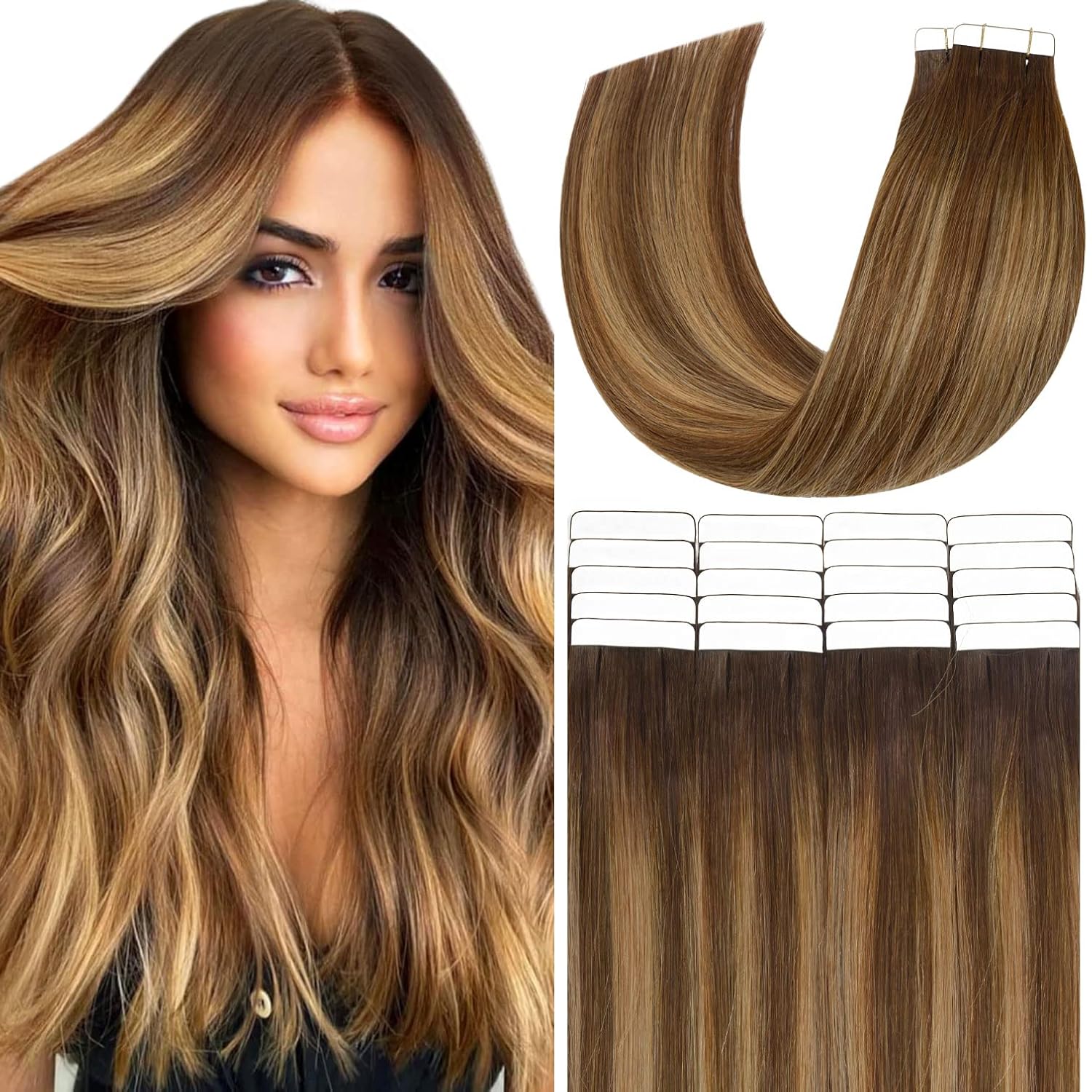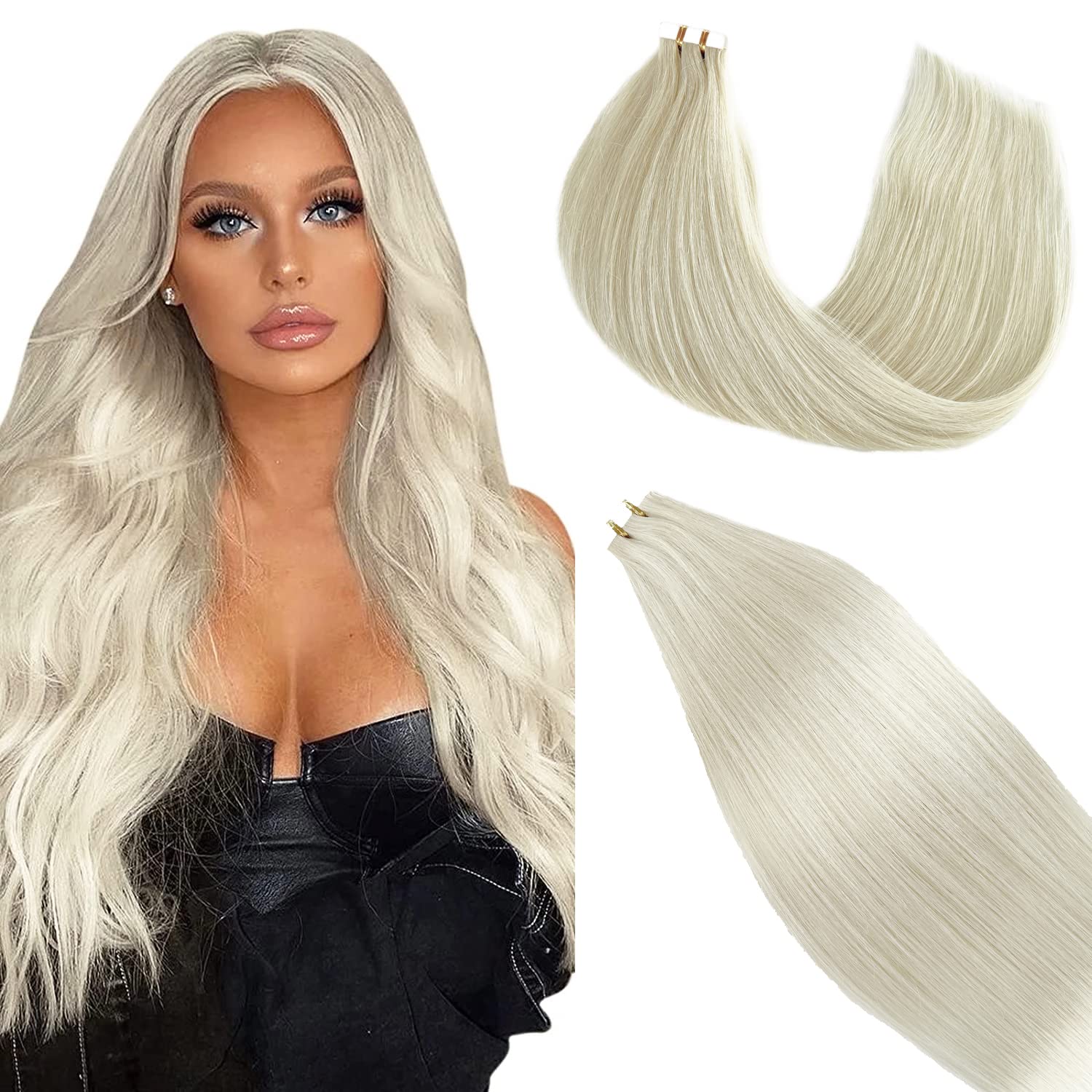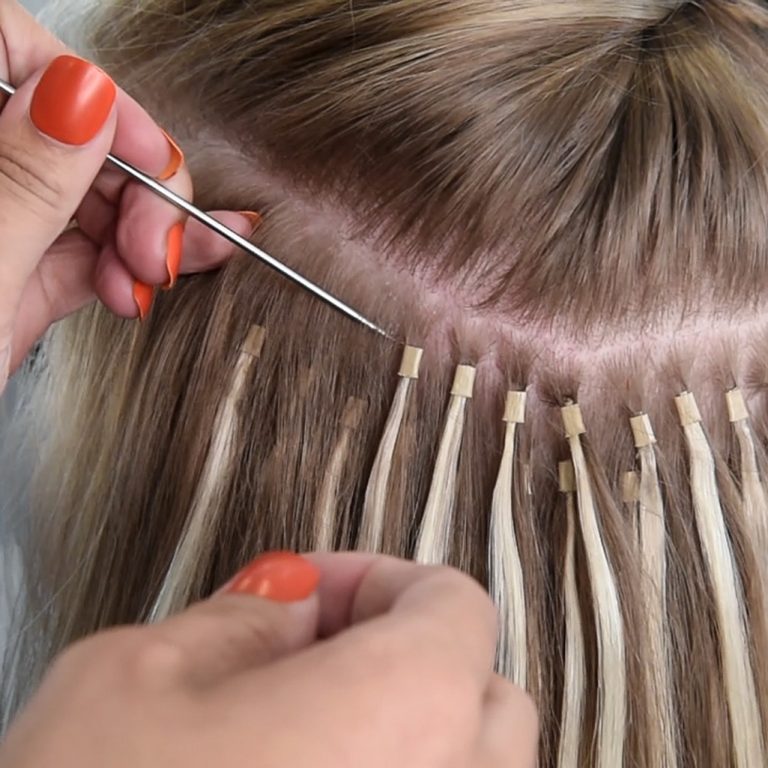
Can You Reuse Tape in Extensions? The Benefits and Proper Care
Introduction to Tape-In Hair Extensions
Can you reuse tape in extensions? Tape-in hair extensions are a popular and versatile choice for adding length and volume to natural hair. These extensions are lightweight and can be applied without causing damage to your hair.
What Are Tape-In Extensions?
Tape-in extensions consist of wefts of hair attached to adhesive tape. The tape is applied to your natural hair near the roots, creating a seamless bond. These extensions are known for their discreet appearance and are ideal for achieving a natural look.
Typically, tape-in extensions are made from human hair or synthetic fibers. Human hair extensions offer a more realistic appearance and greater versatility for styling. They can be cut, curled, or colored to match your preferences.
Common Benefits of Using Tape-In Extensions
- Natural Appearance: Tape-in extensions blend seamlessly with your hair, enhancing your overall look.
- Low Maintenance: These extensions are easy to maintain and require minimal daily care.
- Damage-Free Application: Proper installation ensures your natural hair remains unharmed.
- Comfort: Tape-ins are lightweight, making them comfortable to wear for long periods.
- Reusability: With the right care, tape-in extensions can be reused multiple times.
- Customizable Style: They can be personalized to match your preferred color, length, and texture.
Tape-in extensions are suitable for various occasions, ranging from casual outings to formal events. Their durability and flexibility make them a reliable solution for those looking to enhance their hair temporarily or long-term.
 Key Considerations for Reusing Tape in Extensions
Key Considerations for Reusing Tape in Extensions
When reusing tape in extensions, several factors determine their success and longevity. Proper care is essential for maintaining the adhesive’s effectiveness and ensuring the hair remains in good condition. Below are important considerations to keep in mind before reapplying tape-in extensions.
Factors That Affect Tape Longevity
- Quality of the Original Tape: The durability of the original adhesive impacts how well tape-in extensions last. High-quality tape provides a stronger and longer-lasting bond.
- Proper Hair Care: Using the right hair care products prevents tape breakdown. Avoid oils and alcohol-based products that weaken the adhesive.
- Frequency of Wear: Extensions worn daily may experience faster wear and tear compared to occasional use.
- Exposure to Heat and Moisture: Excessive heat from styling tools or regular water exposure can weaken the tape.
- How Often You Reapply: Reusing tape too frequently without proper preparation lowers its adhesion over time.
Signs It’s Time to Replace the Tape
- Weakening Bond: If the extensions start slipping or feel loose, the adhesive may have degraded.
- Visible Residue: Remaining glue or residue can reduce the tape’s stickiness and cause discomfort.
- Uneven Application: If the extensions no longer sit flat against your scalp, replacing the tape is necessary.
- Skin Irritation: Tape causing redness or itching may no longer be effective and should be replaced.
- Frequent Reapplication: If you’ve already reused the tape multiple times, consider applying new adhesive for a secure hold.
Understanding these factors and indicators helps maintain the integrity of tape-in extensions, ensuring a clean and strong reapplication process.
Preparing to Reuse Tape in Extensions
Reusing tape-in extensions requires careful preparation to maintain quality and adhesive strength. Cleaning, removing old residue, and choosing the right tape are key steps. Follow these guidelines to ensure your extensions are ready for reapplication while minimizing damage.
Cleaning the Extensions Properly
- Start with Detangling: Use a wide-tooth comb to remove any knots or tangles.
- Wash Thoroughly: Clean the extensions using sulfate-free shampoo to remove dirt and oils.
- Rinse Completely: Rinse with lukewarm water to remove any leftover product.
- Condition with Care: Apply a light conditioner to keep the hair soft, avoiding the tape area.
- Air Dry Fully: Allow the extensions to air dry completely before moving on.
Proper cleaning extends the life of the hair and prepares it for new adhesive application.
Removing Old Adhesive Residue
- Use a Tape Remover: Apply hair extension tape remover to dissolve the old adhesive.
- Gently Scrub Residue: Use a soft cloth or your fingers to remove the loosened tape.
- Clean with Alcohol: Wipe the tape area with isopropyl alcohol to ensure no residue remains.
Thorough adhesive removal is crucial for a strong reapplication.
Selecting the Right Replacement Tape
- Choose High-Quality Tape: Select professional-grade, double-sided tape to ensure a secure bond.
- Match Tape Size: Use tape strips that suit the size of your extensions.
- Check Compatibility: Make sure the replacement tape works with the material of your extensions.
- Opt for Long-Lasting Adhesive: Look for tapes designed for extended wear to reduce frequent reapplication.
Picking the right tape improves longevity and ensures a seamless blend with your hair.
By following these steps, you’ll prepare your tape-in extensions effectively, ensuring they stay secure and look natural.
 Step-by-Step Guide to Reapplying Tape to Extensions
Step-by-Step Guide to Reapplying Tape to Extensions
Reapplying tape to extensions requires attention to detail. Follow this step-by-step guide for the best results. Properly prepared extensions and precise application ensure a secure and natural finish.
Ensuring Extensions Are Fully Cleaned and Dry
- Double-Check Cleanliness: Ensure no adhesive or residue remains on the hair wefts.
- Dry Thoroughly: Air dry the extensions completely. Avoid using heat to protect the hair quality.
- Inspect the Wefts: Confirm that each piece is smooth and free of tangles before moving forward.
Cleaning and drying extensions fully helps the new tape stick securely and last longer.
Applying New Tape Correctly
- Measure the Tape: Cut the tape strips to fit the width of the extension wefts.
- Attach Tape Smoothly: Place the adhesive side on the top edge of the extension, avoiding wrinkles.
- Firmly Press the Tape: Run your fingers over the tape to secure it to the weft.
- Prepare for Application: Double-check the placement to ensure no gaps or uneven areas exist.
Proper tape application creates a strong and seamless bond when reattaching to natural hair.
Tips for Achieving a Strong Bond
- Clean Natural Hair: Wash and dry your own hair to remove oils and buildup.
- Avoid Touching the Tape: Handle the tape from the edges to keep the adhesive clean.
- Apply with Precision: Align the extensions close to the roots without touching the scalp.
- Press Firmly After Applying: Use the back of a comb to press the tape firmly into place.
These steps will help you achieve a durable bond, keeping the extensions secure for weeks. Regular maintenance ensures longer-lasting results and reduces the need for frequent reapplication.
Maintenance Tips for Long-Lasting Tape-In Extensions
Proper maintenance of tape-in extensions ensures extended use and keeps them looking natural. Following the right practices prevents damage and helps maintain their quality. Below are essential tips to keep your extensions in top condition.
Avoiding Products That Weaken Adhesive
- Stay Away from Oily Products: Avoid oil-based shampoos, conditioners, or serums as they weaken the tape bond.
- Limit Alcohol-Based Sprays: Alcohol in hair sprays can dry out adhesive, causing tapes to slip.
- Choose Sulfate-Free Formulas: Use sulfate-free hair care products to gently cleanse hair without breaking down the tape.
- Avoid Heavy Creams: Don’t over-apply thick conditioners near the tape area to prevent adhesive lifting.
By using the right products, you’ll maintain a strong tape bond and keep your extensions secure.
How to Store Extensions Safely When Not in Use
- Clean Before Storing: Wash and air dry the extensions completely to remove oils and residue.
- Detangle Gently: Use a wide-tooth comb to remove knots before storing them.
- Use a Storage Bag: Keep extensions in a protective bag to prevent tangling and dust buildup.
- Avoid Folding: Lay extensions flat or use a hanger to preserve their shape.
- Store in a Cool, Dry Place: Keep extensions away from direct sunlight and humid environments.
Proper storage extends the life of your tape-in extensions, keeping them fresh for reuse.
Proper Styling Practices to Prevent Damage
- Avoid Excessive Heat: Use low-heat settings when styling to prevent damaging the tape or hair fibers.
- Be Gentle When Brushing: Use a soft-bristle brush and avoid tugging near the tape area.
- Limit Chemical Treatments: Avoid coloring or bleaching extensions without professional guidance.
- Separate the Wefts: Keep the extensions separated during heat-styling to avoid tangling.
- Tie Hair Loosely: Use loose hairstyles when sleeping to prevent tape strain.
Gentle handling and mindful styling play a big role in ensuring long-lasting extensions.
 Expert Tips for Maximizing the Lifespan of Tape in Extensions
Expert Tips for Maximizing the Lifespan of Tape in Extensions
To extend the lifespan of tape used in extensions and maintain safety, consider these expert tips:
Choose High-Quality Tape
Invest in high-quality electrical tape designed for long-term use. Premium tapes offer better adhesive properties and durability, ensuring they remain effective for extended periods.
Apply Multiple Layers Carefully
Using multiple layers can enhance the insulation provided by the tape. However, ensure that each layer is applied correctly without excessive overlapping to maintain flexibility and prevent peeling.
Store Tape Properly
Proper storage of both used and unused tape can preserve its adhesive qualities. Keep tape in a cool, dry place away from direct sunlight and extreme temperatures to prevent degradation.
Use Tape Sparingly
Apply only the necessary amount of tape to cover exposed wires and connections. Overuse can make the extensions cumbersome and reduce the tape’s effectiveness.
Incorporate Regular Maintenance
Integrate tape inspections and replacements into your regular maintenance routine. This proactive approach helps identify and address issues before they escalate into safety hazards.
 Frequently Asked Questions About Reusing Tape in Extensions
Frequently Asked Questions About Reusing Tape in Extensions
Addressing common queries can provide further clarity on the topic. Here are some frequently asked questions:
Can you reuse tape in extensions safely?
Yes, can you reuse tape in extensions if the tape is in good condition, free from damage, and made from appropriate materials. However, it’s crucial to inspect the tape thoroughly and ensure it meets safety standards before reuse.
What type of tape is best for electrical extensions?
Electrical tape is the best choice for electrical extensions due to its insulating properties and durability. It is specifically designed to handle electrical currents and provide reliable protection against short circuits.
How many times can tape be reused in extensions?
The number of times tape can be reused depends on its condition. Generally, tape should only be reused once and then replaced with a fresh piece to ensure optimal safety and performance.
What are the signs that tape in extensions needs replacement?
Signs that tape needs replacement include loss of adhesive strength, brittleness, cracks, discoloration, and any visible damage. Additionally, if the tape no longer provides a secure seal, it should be replaced immediately.
Is reusing tape in extensions cost-effective?
Reusing tape can be cost-effective in the short term, but it may compromise safety and performance. The potential risks associated with degraded tape can lead to more significant expenses in the long run, such as electrical repairs or replacements.
Can I reuse duct tape in electrical extensions?
No, you should not reuse duct tape in electrical extensions as it lacks the necessary insulating properties and can pose significant safety risks. Always use tape designed specifically for electrical applications.
How do I remove old tape from extensions?
To remove old tape, gently peel it off starting from one edge. Use a clean cloth and a mild solvent, if necessary, to remove any remaining adhesive residue. Ensure the surface is clean and dry before applying new tape.
Are there eco-friendly alternatives to reusing tape in extensions?
Yes, eco-friendly alternatives include using heat shrink tubing, recycled electrical tape, or biodegradable insulating materials. These options provide sustainable ways to protect electrical connections without compromising safety.
 Final Thoughts on Reusing Tape in Extensions
Final Thoughts on Reusing Tape in Extensions
Can you reuse tape in extensions? Reusing tape-in extensions is a practical choice when done correctly. It helps you save money and extend the life of your extensions. Proper preparation, cleaning, and maintenance are crucial for achieving the best results. Let’s summarize the advantages and challenges of reusing tape and discuss when professional help might be necessary.
Pros and Cons of Reusing Tape
Pros:
- Cost-Effective: Reusing extensions reduces the need to frequently buy new ones.
- Environmentally Friendly: Reuse minimizes waste, promoting less consumption of new materials.
- Customizability: You can retape and style extensions to match your needs over time.
- Reliable Results: High-quality tape maintains attachment strength with proper care.
Cons:
- Time-Consuming: Cleaning and preparing extensions take effort and patience.
- Risk of Adhesive Failure: If not done properly, reused tape may not adhere well.
- Hair Damage Risks: Incorrect reapplication can stress natural hair or cause discomfort.
- Wear and Tear: Extensions may degrade after several reuse cycles, impacting their appearance.
Understanding these pros and cons helps you decide if reusing tape is right for you.
When to Seek Professional Help
- If the Extensions Show Damage: Seek professional advice if the hair wefts appear frayed or damaged.
- When Reapplication Feels Challenging: A hairstylist ensures precise re-taping and avoids common mistakes.
- If You Notice Adhesive Problems: Experts can recommend the right tape for better results.
- For Styling Needs: Whether cutting, coloring, or blending extensions, professionals achieve a flawless look.
- If Extensions Feel Uncomfortable: A trained stylist can adjust placement to ensure comfort and security.
While reusing tape-in extensions can be a DIY process, professional help guarantees a polished finish and keeps your natural hair healthy. Choose the best route for your needs to enjoy long-lasting, beautiful results.

